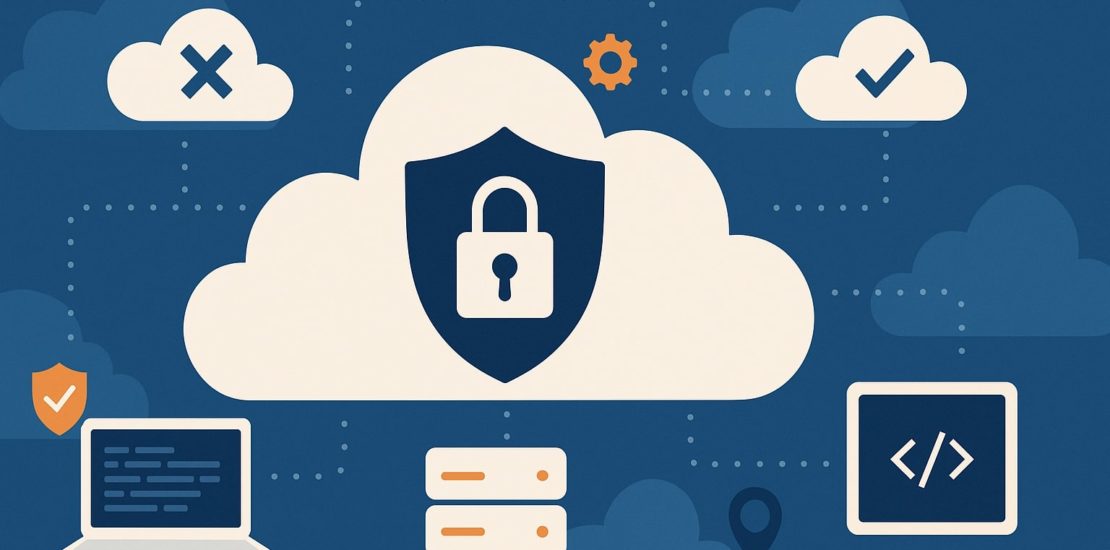Why Cloud Security Posture Management (CSPM) Is No Longer Optional in 2025
- August 5, 2025
- Posted by: Gradeon
- Categories: Compliance, Cyber Security

In 2025, the cloud is no longer the future—it’s the present. Organisations across every sector are adopting cloud services at an unprecedented rate. While this shift offers scalability, flexibility, and innovation, it also introduces new security challenges. As traditional security methods struggle to keep pace with modern cloud complexity, Cloud Security Posture Management (CSPM) has emerged as a vital component of any robust cybersecurity strategy.
If your business uses cloud infrastructure—whether it’s AWS, Azure, or Google Cloud—then understanding CSPM is no longer optional. It’s essential.
What Is Cloud Security Posture Management (CSPM)?
CSPM refers to a category of security solutions specifically designed to identify and fix misconfigurations and compliance risks in cloud environments. Unlike legacy security tools that primarily focus on detecting threats after they occur, CSPM tools take a proactive approach.
They continuously monitor cloud environments to ensure configurations follow best practices, detect vulnerabilities, and align with regulatory standards. This allows organisations to address security gaps before they can be exploited, making CSPM an indispensable tool for managing cloud risk.
Why CSPM Is Crucial in 2025
1. Explosion of Cloud Usage
As businesses increasingly move operations to the cloud, the size and complexity of cloud environments grow rapidly. This rapid expansion often leads to inconsistent security controls, siloed configurations, and overlooked vulnerabilities. CSPM brings order to this chaos by offering unified visibility and governance across multiple cloud services.
2. Misconfigurations Are a Leading Cause of Data Breaches
Studies have shown that the majority of cloud-related breaches are due to misconfigurations—such as publicly exposed storage buckets or unrestricted firewall rules. These are often simple human errors. CSPM tools automatically detect such misconfigurations and provide alerts or even auto-remediate them before damage is done.
3. Increased Compliance Pressures
With regulations like GDPR, PCI DSS, ISO 27001, and DORA tightening their requirements, businesses are under pressure to ensure their cloud environments are compliant. CSPM automates compliance audits, generates reports, and tracks security controls to help organisations stay compliant without manual overhead.
4. The Rise of Multi-Cloud Architectures
Today’s enterprises rarely rely on just one cloud provider. Multi-cloud strategies offer flexibility but introduce fragmented security practices. CSPM tools centralise visibility and policy enforcement across platforms, making it easier to manage and secure diverse cloud environments from a single dashboard.
5. Real-Time Threat Detection
CSPM doesn’t just scan your cloud setup once a month. It offers continuous monitoring, detecting deviations from policies, suspicious activities, and unauthorised changes in real time. This level of visibility is critical in stopping security incidents before they escalate.
Key Capabilities of CSPM Solutions
To truly understand the value of CSPM, it’s worth highlighting the specific features that make it so effective:
- Automated Asset Discovery: Instantly identifies all resources in your cloud environment, including shadow IT.
- Misconfiguration Detection: Flags settings that deviate from security best practices.
- Compliance Mapping: Aligns configurations with regulations like HIPAA, SOC 2, NIST, and more.
- Security Benchmarking: Compares your cloud posture against industry benchmarks such as CIS (Centre for Internet Security).
- Risk Prioritisation: Categorises risks based on severity to help teams focus on what matters most.
- Integration with DevOps: Embeds security checks into the CI/CD pipeline, supporting shift-left practices.
- Automated Remediation: Applies predefined policies to fix issues automatically, reducing manual intervention.
Who Needs CSPM?
While CSPM benefits any organisation operating in the cloud, certain sectors stand out due to their unique risks and compliance requirements:
Enterprises with Multi-Cloud Environments
Large corporations often have sprawling cloud infrastructures involving multiple teams and vendors. CSPM provides the unified control they need to secure all accounts consistently, regardless of provider.
Rapidly Scaling Start-Ups
Start-ups often prioritise speed over security, which can result in insecure cloud configurations. CSPM offers an easy way to build security into their operations without slowing down development.
Financial Institutions
With high volumes of sensitive data and strict regulatory oversight (e.g. DORA and PCI DSS), financial institutions rely on CSPM to ensure ongoing compliance and reduce audit burdens.
Healthcare Providers
The healthcare sector handles large volumes of personal and medical data under frameworks like GDPR. CSPM helps ensure patient information remains protected and accessible only to authorised users.
E-Commerce Platforms
Online retailers collect customer data and payment details, making them attractive targets for cybercriminals. CSPM enables real-time security posture management to prevent downtime and safeguard consumer trust.
Best Practices for Implementing CSPM
Adopting a CSPM solution is just the beginning. To get the most value from it, follow these best practices:
- Establish a Baseline Configuration
Define what “secure” looks like for your organisation by setting up cloud security policies and compliance frameworks from the start. - Integrate with DevOps
Shift security left by embedding CSPM tools into your development pipeline. This ensures that issues are caught early, not after deployment. - Automate Where Possible
Enable auto-remediation for non-critical issues to save time and reduce human error. - Train Your Teams
Make sure developers, DevOps, and security teams understand how the CSPM tool works and how to interpret its findings. - Review Dashboards Regularly
Set aside time weekly or monthly to review reports and metrics. Staying informed helps with decision-making and continuous improvement.
Conclusion
Cloud adoption is accelerating—and so are the associated risks. Cybercriminals are becoming more sophisticated, regulations more demanding, and cloud infrastructures more complex. In this fast-moving environment, relying solely on traditional security tools is a recipe for disaster.
Cloud Security Posture Management provides a necessary layer of protection, helping you proactively manage risks, maintain compliance, and stay ahead of threats. Whether you’re a fast-growing start-up or a global enterprise, investing in CSPM in 2025 is not just smart—it’s non-negotiable.
By embedding CSPM into your cloud security strategy, you not only safeguard your data but also earn the trust of customers, partners, and regulators alike.
